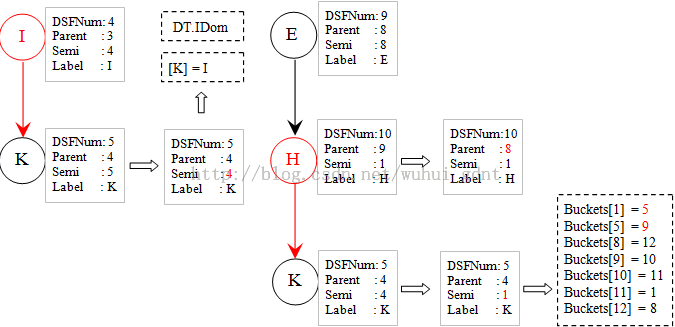dsa算法(16)
1.3.2.2.2.Lengauer-Tarjan算法第二、第三步
在174行,GraphTraits<FuncT*>::size(&F)返回F所代表的函数中的基本块的个数,但因为isPostDominator返回false,因此MultipleRoots维持为0。
Calculate(续)
172 // it might be thatsome blocks did not get a DFS number (e.g., blocks of
173 // infinite loops). In these cases an artificial exit nodeis required.
174 MultipleRoots|= (DT.isPostDominator() && N !=GraphTraits<FuncT*>::size(&F));
175
176 // When naivelyimplemented, the Lengauer-Tarjan algorithm requires a separate
177 // bucket for each vertex. However, this is unnecessary,because each vertex
178 // is only placedinto a single bucket (that of its semidominator), and each
179 // vertex's bucketis processed before it is added to any bucket itself.
180 //
181 // Instead of usinga bucket per vertex, we use a single array Buckets that
182 // has two purposes. Before the vertex V with preordernumber i is processed,
183 // Buckets[i] stores the index of the firstelement in V's bucket. After V's
184 // bucket isprocessed, Buckets[i] stores the index of the next element in the
185 // bucketcontaining V, if any.
186 SmallVector<unsigned, 32> Buckets;
187 Buckets.resize(N + 1);
188 for (unsignedi = 1; i <= N; ++i)
189 Buckets[i] = i;
190
191 for (unsignedi = N; i >= 2; --i) {
192 typenameGraphT::NodeType* W = DT.Vertex[i];
193 typenameDominatorTreeBase<typenameGraphT::NodeType>::InfoRec &WInfo =
194 DT.Info[W];
195
196 // Step #2:Implicitly define the immediate dominator of vertices
197 for(unsigned j = i; Buckets[j] != i; j = Buckets[j]) {
198 typenameGraphT::NodeType* V = DT.Vertex[Buckets[j]];
199 typenameGraphT::NodeType* U = Eval<GraphT>(DT, V, i + 1);
200 DT.IDoms[V] = DT.Info[U].Semi < i ? U: W;
201 }
在Lengauer-Tarjan论文里原来使用bucket(w)保存半支配者为w节点的节点集合。这里做了改进,不再需要为每个节点保留一个集合,而是共用一个Buckets数组。理由是,首先每个节点只会放入一个bucket(因为其半支配者节点是唯一的)。更重要的是,bucket(v)中每个节点(即以v作为半支配者节点)都在v放入bucket之前得到处理。因此,这里所有的节点都共用一个Buckets,一开始Buckets与节点序号一一对应,而在处理过程中Buckets构成多个链,具有相同半支配者节点的节点通过某个链形成一个闭环。
192行的DT.Vertex[i]是第一步按深度优先遍历第i个访问到的节点,因此191行的循环是按降序进行第二、第三步计算。第二步的依据是Lengauer-Tarjan论文里的定理4。这个定理的内容是:
对于任何顶点w ≠ r,sdom(w) = min ({ v | (v, w) ∈ E且v < w } ∪ { sdom(u) | u > w且存在存在一条边(v,w)使得u*àv })(记法x*ày,表示x是y在伸展树中的一个祖先,E是边的集合)
第三步的依据则是论文中的推论1:假设w ≠ r,且v满足条件:在满足路径sdom(w)+à u*àw的u中,sdom(v)最小。那么
Calculate(续)
203 // Step #3:Calculate the semidominators of all vertices
204
205 // initialize thesemi dominator to point to the parent node
206 WInfo.Semi = WInfo.Parent;
207 typedefGraphTraits<Inverse<NodeT> > InvTraits;
208 for (typename InvTraits::ChildIteratorType CI =
209 InvTraits::child_begin(W),
210 E = InvTraits::child_end(W); CI != E;++CI) {
211 typenameInvTraits::NodeType *N = *CI;
212 if (DT.Info.count(N)) { // Only if thispredecessor is reachable!
213 unsigned SemiU = DT.Info[Eval<GraphT>(DT,N, i + 1)].Semi;
214 if (SemiU < WInfo.Semi)
215 WInfo.Semi = SemiU;
216 }
217 }
218
219 // If V is anon-root vertex and sdom(V) = parent(V), then idom(V) is
220 // necessarilyparent(V). In this case, set idom(V) here and avoid placing
221 // V into abucket.
222 if (WInfo.Semi == WInfo.Parent) {
223 DT.IDoms[W] = DT.Vertex[WInfo.Parent];
224 } else {
225 Buckets[i] = Buckets[WInfo.Semi];
226 Buckets[WInfo.Semi] = i;
227 }
228 }
207行的GraphTraits<Inverse<NodeT>>就是GraphTraits<Inverse<const BasicBlock*> >,它是一个GraphTraits的特化类型。
296 template <> struct GraphTraits<Inverse<const BasicBlock*> > {
297 typedef const BasicBlock NodeType;
298 typedefconst_pred_iterator ChildIteratorType;
299 staticNodeType *getEntryNode(Inverse<constBasicBlock*> G) {
300 returnG.Graph;
301 }
302 static inline ChildIteratorType child_begin(NodeType *N) {
303 returnpred_begin(N);
304 }
305 static inline ChildIteratorType child_end(NodeType *N) {
306 returnpred_end(N);
307 }
308 };
在这个特化类型定义中,pred_begin与pred_end分别返回这样的迭代器:
89 inline const_pred_iteratorpred_begin(const BasicBlock *BB) {
90 returnconst_pred_iterator(BB);
91 }
93 inline const_pred_iterator pred_end(const BasicBlock *BB) {
94 returnconst_pred_iterator(BB, true);
95 }
迭代器const_pred_iterator的定义则是:
85 typedef PredIterator<const BasicBlock,
86 Value::const_use_iterator> const_pred_iterator;
PredIterator定义的是节点前驱(Predecessor)迭代器。它接受两个模板参数,第一个是迭代对象,这里是BasicBlock* BB;第二个是该对象真正使用的迭代器,这里是Value::const_use_iterator,即value_use_iterator<constUser>。
47 explicit inline PredIterator(Ptr*bb) : It(bb->use_begin()) {
48 advancePastNonTerminators();
49 }
47行的use_begin返回指向定义使用链(def-uselist)开头的迭代器,对于BasicBlock其定义使用链的内容就是其前驱节点(即前驱与该BasicBlock构成图中的一条边)。
显然上面208行的循环是遍历192行的w节点的前驱。212行确认指定的前驱节点在深度优先遍历中被访问到了。对于这个前驱节点v,通过下面的函数Eval执行如下操作:
如果v是森林中一棵树的根节点,就返回v。否则,假设r是森林中包含v的树的根节点。返回在路径r*àv上的节点u,满足u ≠ r,且semi(u) 最小。而这个森林则包含顶点集V及(树)边集合 { (parent(w), w) | 顶点w已经被处理 }。
106 template<classGraphT>
107 typename GraphT::NodeType*
108 Eval(DominatorTreeBase<typename GraphT::NodeType>& DT,
109 typenameGraphT::NodeType *VIn, unsigned LastLinked) {
110 typenameDominatorTreeBase<typenameGraphT::NodeType>::InfoRec &VInInfo =
111 DT.Info[VIn];
112 if (VInInfo.DFSNum < LastLinked)
113 return VIn;
114
115 SmallVector<typenameGraphT::NodeType*, 32> Work;
116 SmallPtrSet<typenameGraphT::NodeType*, 32> Visited;
117
118 if (VInInfo.Parent >= LastLinked)
119 Work.push_back(VIn);
120
121 while(!Work.empty()) {
122 typenameGraphT::NodeType* V = Work.back();
123 typenameDominatorTreeBase<typenameGraphT::NodeType>::InfoRec &VInfo =
124 DT.Info[V];
125 typenameGraphT::NodeType* VAncestor = DT.Vertex[VInfo.Parent];
126
127 // ProcessAncestor first
128 if (Visited.insert(VAncestor) &&VInfo.Parent >= LastLinked) {
129 Work.push_back(VAncestor);
130 continue;
131 }
132 Work.pop_back();
133
134 // Update VInfobased on Ancestor info
135 if (VInfo.Parent < LastLinked)
136 continue;
137
138 typenameDominatorTreeBase<typenameGraphT::NodeType>::InfoRec &VAInfo =
139 DT.Info[VAncestor];
140 typenameGraphT::NodeType* VAncestorLabel = VAInfo.Label;
141 typenameGraphT::NodeType* VLabel = VInfo.Label;
142 if (DT.Info[VAncestorLabel].Semi < DT.Info[VLabel].Semi)
143 VInfo.Label = VAncestorLabel;
144 VInfo.Parent = VAInfo.Parent;
145 }
146
147 returnVInInfo.Label;
148 }
我们用个例子来观察上面的代码,这个例子来自Lengauer-Tarjan论文。它是这样一个图,实线组成的是该图深度优先遍历的伸展树,虚线是非树边。
这棵树一共有13个节点,上面191行的循环从序号最大的叶子节点开始,以序号的倒序遍历树节点。循环第一遍时处理节点L,其前驱是D,L同时是所在子树的根节点:
这时森林只包含[D, L]两个节点,及一条路径(D, L),而D是子树D->L的根节点。
循环i = 12时,处理节点D,其前驱是A和B。在处理前驱B时,由于D的semi被更新为8,其序号被放入Buckets[8]中,这时Buckets[8]->Buckets[12]->Buckets[8]构成一个闭环。循环i = 11时,处理节点A,其前驱是B和R。处理B时森林只有一棵树,由节点A,B,D和L组成,处理R时森林由两棵子树组成,一棵与处理B时相同,另一棵则只包含节点R。因为现在A的semi是1,因此它的序号被放入Buckets[1]。这时Buckets[1]->Buckets[11]->Buckets[1]构成闭环。
循环i = 10时,处理节点H,其前驱是E和L。注意节点L所在的(森林中)树。Eval将L的Label,Parent及Semi都设得与A一致,这在Lengauer-Tarjan算法中称为路径压缩(我们只要访问L,就知道B->L这棵树上具有最小semi的节点)。因为现在H的semi是1,因此它的序号被放入Buckets[1]。这时Buckets[1]->Buckets[10]->Buckets[11]->Buckets[1]构成闭环。
在循环i = 9时,处理节点E,其前驱是B和H。这个时候森林中有节点[B, A, D, L, H],构成一棵具有边B->A,A->D,D->L,B->E,E->H的树。由于路径压缩的缘故,H给出了这棵子树中,除根节点外最小的semi值。因为现在E的semi是1,因此它的序号也放入Buckets[1],Buckets[1]->Buckets[9]->Buckets[10]->Buckets[11]->Buckets[1]构成闭环。

在循环i = 8时,处理节点B,其前驱是R。但因为这时Buckets[8]不是8,因此197行的循环将处理Buckets[8],Buckets[12],这两个都是semi(暂定)为8的节点。注释中写错了,这实际上对应Lengauer-Tarjan算法的第三步,而第二步才是第三步。
目前的森林是以B为根节点的子树,由于路径压缩的缘故,D的Parent现在是B。Eval的作用是返回节点所在子树中具有最小semi的节点——这里是A,这正是D节点Label中的内容。不过这两次处理都没有改变任何东西。
在循环i = 7时,处理节点J,其前驱是G,它是所在(森林中的)子树的根节点,这个处理很简单。

在循环i = 6时,处理节点G,其前驱是C,它是所在(森林中的)子树的根节点,这个处理同样简单。

在循环i = 5时,处理节点K,其前驱是I,及H。
由于H节点的传播,K节点的Semi变成1,这样Buckets[1]-> Buckets[5]-> Buckets[9]-> Buckets[10]-> Buckets[11]->Buckets[1]构成新的闭环。
在循环i = 4时,处理节点I,其前驱是F,G,J及K。其中G与J对I没有任何影响。
Buckets[1]->Buckets[4]->Buckets[5]->Buckets[9]->Buckets[10]->Buckets[11]->Buckets[1]构成新的闭环。
在循环i = 3时,处理节点F,其前驱是C。结果是:
类似的,在循环i = 2时,处理节点C,其前驱是B。
至此,我们完成了Lengauer-Tarjan算法的前三步。得到如下所示的图。

而DT.IDoms中的内容则如下图所示:
Calculate(续)
230 if (N >= 1) {
231 typenameGraphT::NodeType* Root = DT.Vertex[1];
232 for(unsigned j = 1; Buckets[j] != 1; j = Buckets[j]) {
233 typenameGraphT::NodeType* V = DT.Vertex[Buckets[j]];
234 DT.IDoms[V] = Root;
235 }
236 }
接下来在230行,遍历Buckets中Semi为1的节点,把它们的直接支配者设置为根节点。因此对我们的例子,DT.IDoms变为:




